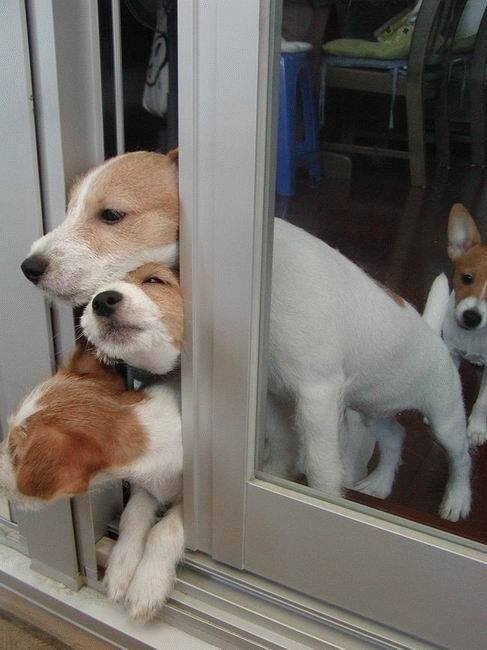Table of Contents
*This post may contain affiliate links. As an Amazon Associate we earn from qualifying purchases.
A lot of us dream of working in a dog-welcoming workspace. But what if you’re in a position to make that a reality? It may be easier than you think.
Would you like your workplace to open its doors to your Jack? Or better yet, have you been asked for suggestions for how to make this happen?
Here are a few tips to make your office a dog-friendly workplace.
#1: Make Sure It’s Allowed

Specifically, would allowing dogs onsite create a health or safety hazard under OSHA or local laws?
Also, are there any insurance, building, or zoning regulations that would prohibit onsite pets?
The last thing you want is for your employer to run into legal trouble.
#2: Establish Dog-Safe Areas

After legal considerations, this is probably the most important step.
First, some areas are safe for dogs, and some are not.
Does your workplace have areas with heavy machinery? Are there unfenced outside spaces where a dog might escape? Is traffic a problem? What about exposure to chemicals or other hazardous materials?
These things pose hazards for humans, too, which is why there are strict rules about workplace safety. If you’re going to bring dogs into the equation, you need new rules and procedures to protect them, as well.
#3: Designate Relief and Exercise Areas

We’re all happiest when our physical needs are met. Once you’ve figured out where visiting dogs will be safe, set aside spaces where they can do their business and blow off steam after watching you do yours.
Does your office have a grassy area behind the building? Or perhaps part of the courtyard? In a pinch, you could even fence off part of the parking lot to provide a relief area. Just make sure to clean up.
#4: Designate People-Only Areas
What? Isn’t that exactly the opposite of what we were just talking about?
Not really.
One of the most important aspects of creating a dog-welcoming workplace is to accept that not everyone will welcome them.
Some people are allergic to dogs. Some people are afraid of them. Some people just don’t want to deal with the hair or noise or mess that comes with pets. And, let’s face it, some clients may be turned off if they’re set upon by a pack of pooches the minute they walk in the door.
And that’s fine.
But what can you do about it?
The respectful thing is to create a clearly-marked and limited area where dogs are allowed.
You might have a special dog area, for example: a room or outdoor patio. You could also allow dogs in people’s offices or cubicles, but not in common areas.
The best way to make sure dogs are welcome is to respect the wishes of those who may not welcome them.
#5: Establish Rules

Rules keep everyone safe and happy — including your dogs.
For example, some of your colleagues may be looking forward to bringing treats for people’s dogs. Great!
But what about dogs who are following medical diets, or who themselves have food allergies?
Some dogs are also food-aggressive, and feeding them in the workplace can cause conflict with other dogs, or even result in a bite.
And does everyone know what sorts of foods are good for dogs, and which foods can harm them?
A well-thought-out and clearly posted set of rules can keep this issue, and others, from getting in the way of fun.
Some sample rules for a dog-friendly workspace

- Only feed dogs with the owner’s knowledge and permission
- No dogs in common or client-facing areas
- Please clean up thoroughly after your dog
- Dispose of all dog waste in outside receptacles
- Keep dogs on a lead at all times
- Notify owners of any problems or misbehavior from their dog
- All pets must be vaccinated, with vaccination records on file
- Onsite pets must use flea control
- Please keep pets off the furniture
- All animals must check in and out at the beginning and end of their stay
Setting down the rules

If your workspace is serious about becoming dog-friendly, the best way to establish rules is with everyone’s input, whether they’re planning to bring their dog to work or not.
Have a meeting. Brainstorm problems and solutions. Listen with an open mind to objections and concerns.
If everyone has a chance to participate in the process, then everyone will feel that they have a stake in making the process work.
And once your office has agreed to a set of rules, post them clearly where everyone will see them.
#6: Have Contingency Plans

Once you’ve established rules about dogs in your workspace, and made arrangements that everyone is happy with, it’s time to think about possible problems.
What would you do, for example, if a dog was injured at your workplace? Or if a disaster occurred? Or if two dogs got a bit rough with one another?
What would you do if, heaven forbid, someone’s dog bit a coworker or a client?
It’s important to have a plan. Maybe even more than one.
- Establish an evacuation and disaster plan that includes onsite pets
- Put together a pet first aid kit for minor injuries
- Look into additional insurance, in case of major injuries or bites to humans
- Establish a procedure for dealing with complaints and incidents
- Know your local vet and emergency vet
#7: Keep a Cleanup Kit

With even the best laid plans, poop happens. So do a lot of other dirty, smelly, stain-making messes. So be prepared.
Picking up
The first step to cleaning up a mess is to physically remove it. Here are a few things to keep in your cleanup kit:
- Waste bags
- Wipes, rags, towels, etc.
- Latex gloves
- Lint rollers for hair
Disinfecting
It’s not enough to simply remove bodily excretions. You must also disinfect, in order to prevent spreading disease to other dogs, and possibly to people as well. So make sure these are in your kit:
- Antibacterial wipes
- Antibacterial carpet shampoos
- Disinfecting spray
- Rags or towels that are only used for waste cleanup
Stains and odor

Once the mess is gone, you’ll want to remove all traces that it was ever there. You’ll need:
- Odor remover such as Febreze, Urine-Off, etc.
- A stain remover that is made for your type of flooring
- Carpet-friendly odor remover, if you have carpets
Happy Workplace, Happy Dogs

Done right, a dog-friendly workplace can be a dream come true. Done wrong, it can be a nightmare for everyone.
The keys to a successful dog-friendly workplace are respect, safety, and preparation.
Do you work in a dog-friendly workplace? We’d love to hear about your experiences!
Featured Image: Public Domain by Senior Airman Benjamin Wiseman, via the U.S. Air Force

